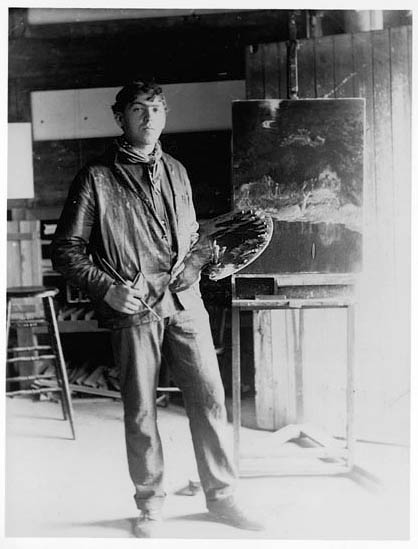 |
| N. C. Wyeth in his studio, c1903 |
Wyeth was gifted as a watercolorist from an early age and studied illustration under Howard Pyle, considered today as the father of American illustration. Pyle taught his students to respect historical accuracy, while adding a romantic flair, traits that became marks of Wyeth's style and surely shaped the imagination of a generation of readers of early frontier fiction.
His first commissioned work was a cover for Saturday Evening Post in 1903 depicting a bucking bronco, and in the following year, he provided illustrations in the same magazine for a western story. Shortly afterward, with the encouragement of Pyle, he travelled widely in the West, soaking up impressions of the landscape, westerners, and Native American culture.
Below are his illustrations for frontier fiction novels published during 1906-1922.
Frank H. Spearman, Whispering Smith (1906)
Alfred Henry Lewis, The Throwback (1906)
Henry Wallace Phillips, Mr. Scraggs (1906)
Stewart Edward White, Arizona Nights (1907)
Thomas Nelson Page, Under the Crust (1907)
Kate and Virgil Boyles, Langford of the Three Bars (1907)
Randall Parrish, Beth Norvell: A Romance of the West (1907)
Frank H. Spearman, Nan of Music Mountain (1916)
Herbert Quick, Vandemark's Folly (1922)
For Tuesday's Overlooked Movies and TV, click on over to Todd Mason's blog, Sweet Freedom.
Further
reading/viewing:
BITS review of Kate and Virgil Boyles, Langford of the Three Bars
Image credits:
From first editions of the novels as indicated
Coming up: Giles A. Lutz, The Honyocker (1961)







I've regarded N. C. Wyeth as the finest western illustrator ever, and own some novels he illustrated.
ReplyDeleteThese 100-year-old books with the artwork intact are treasures.
DeleteThis falls under the, you learn something every day, for me. Most interesting, guess I never really thought about the illustrators. Am reading a book published in 1936 by G. P. Putnam's Sons, with a very nice cover art jacket signed only, DNR, assume it was an artist for the company, but now I would like to find out more. Well off I go to do some research.
ReplyDeleteNeil, let us know what you find out.
DeleteOh, I love these. He is one of my favorite artists. His stuff has such heart.
ReplyDeleteCharles, he also knows how to pump up an image with drama.
DeleteA favorite of mine also. He did many cover paintings for POPULAR MAGAZINE, which was one of the top pulps during the teens and twenties.
ReplyDeleteI was once reading Wyeth's letters and one dealt with his train being delayed because it ran over someone. Tragically, years later, Wyeth tried to beat a train at a crossing and he was killed with his grandson.
I collect illustration art from the pulps and slicks but Wyeth is big time and I can't afford his paintings...
I'm wondering where you would go to see a show of his original work. The National Museum of American Illustration in R? The Delaware Art Museum?
DeleteMy wife and I have visited the Brandywine Museum in Chaddsford, Pa three times during the past 30 years and seen many original paintings of not only NC Wyeth but also of his children and other artists.
DeleteWe have a set of the Wyeth-illustrated classics, the Scribner hardcovers—Robert Louis Stevenson, James Fenimore Cooper, etc.—but I hadn't realized he did so much Western illustration till recently. I've seen color versions of some of the Vandemark's Folly pictures (here, for instance).
ReplyDeleteElisabeth, thanks for the link.
DeleteRon, I'm familiar with N.C. Wyeth's name and I have seen his illustrations online. Unlike in the past I pay close attention to cover art and illustrations in frontier fiction. The black and white paintings are beautiful.
ReplyDeletePrashant, someone here may know for sure, but I believe the black-and-white illustrations appeared originally in color.
DeleteSomewhere I have a book of N. C. Wyeth illustrations. A favorite.
ReplyDeleteTime to dig it out.
DeleteN. C. was the father of Andrew Wyeth, whose spare style is memorable. Peter Hurd is also part of the family. Andrew's painting, Christina's World, is one of the most striking of the 20th century.
ReplyDeleteRichard, thanks for mentioning Andrew.
DeleteWow, he was prolific and having read this have to drop my allusion that NC stood for North Carolina.
ReplyDeleteI've looked at large publications of Wyeth's illustrations, but obviously, they didn't include everything he did. Delightful discovery of his "little western gems." Thanks, Ron. Oh, to run across a dusty old original tossed out of someone's attic.
ReplyDeleteI just finished re-reading the free ebook of "Nan of Music Mountain" from the archive.org site. It has the Wyeth illustrations, but for some reason (possibly due to the method used to copy the book for online publication) they are in black and white. Wish that they could have been produced in color.
ReplyDeleteIn 1903, he created a cover for Saturday Evening Post portraying a bucking bronco, and the following year, he produced graphics for a western storey in the same publication.
ReplyDeleteGoogle Bellen